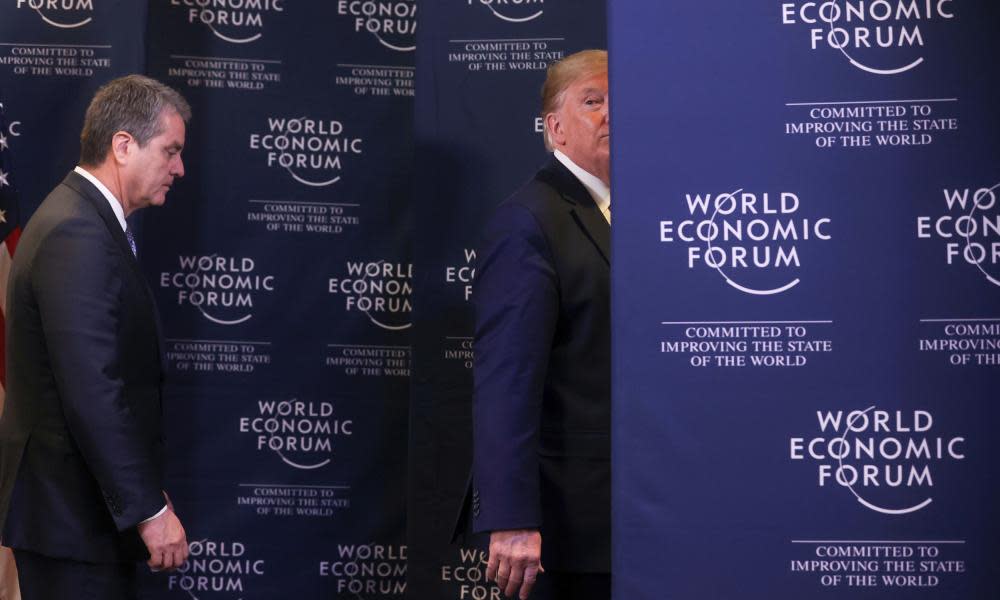Trump saw the economy was his ticket to a second term – then Covid struck

No time to waste. That was the message from Joe Biden as he announced plans for a $1.9tn (£1.4tn) stimulus package only days before his inauguration as US president next week. Combatting the health and economic crises he will inherit from Donald Trump will be top of the agenda for his administration.
The latest jobs figures highlight the problem. In the latest week, the number of new unemployment claims rose by 181,000 to 965,000, the highest weekly figure since August. Record Covid-19 infection rates during the winter months have led to curbs on activity being strengthened, partly as a result of action by individual states and partly because individuals have become more cautious.
As a result, growth has slowed and the improvement in the labour market that followed the initial pandemic shock last spring has gone into reverse. Biden has some experience of this sort of situation because the economy was in similarly poor shape when he became Barack Obama’s vice-president in 2009. Certainly, the economy Trump bequeaths to Biden bears no comparison to the one left to him by Obama.
Trump had seen the economy as his ticket to a second term. At last year’s World Economic Forum in Davos he told assembled members of the global elite: “America is thriving, America is flourishing, and yes, America is winning again like never before.”
Most incumbents tend to be re-elected. Before Trump, the only presidents since the the second world war to have won one election but not a second TERM were Jimmy Carter and George Bush senior. Sitting presidents who preside over even a moderately well-performing economy tend to win with some ease.
And that’s the way it looked like panning out for Trump when he pitched up in Davos. At that point, with unemployment at its lowest since the US was first putting men on the moon in the late 1960s, few would have put much money on Biden capping a long political career with the presidency.
Trump’s determination to focus on the economy meant he downplayed the seriousness of the virus and action to prevent its spread was delayed. But by March, businesses were closing, unemployment was threatening to return to the levels of the 1930s and the markets were crashing.
Watch: Experts weigh in on whether more Republicans will support Trump’s impeachment
As a result, the economy under Trump was divided into two parts: the generally successful first three years followed by a disastrous 2020. By the time he lost to Biden in early November, the US had actually recovered most of the ground lost during the early stages of the pandemic but by then it was too late.
In Trump’s first three years in office, growth averaged 2.5% – a solid if by no means exceptional performance. Despite Trump’s assertions, the US economy had been growing steadily under Obama from the middle of 2009 onwards, with an average annual expansion of 2.25% a year. If the big boost to defence spending under Trump is put to one side, the growth rates under the last two presidents would be pretty much identical – up to the end of 2019 at least. Figures are not yet in for 2020 but the US looks to have contracted by about 4.5%.
The jobs picture looks similar. Under Obama, the jobless rate had more than halved and it was assumed by the US Treasury and the Federal Reserve, America’s central bank, that it could go no lower without inflation picking up. Trump was sceptical about this view and was proved right. Unemployment continued to fall, reaching 3.5% by the end of 2019.
The number of jobs created each year was slightly slower than in Obama’s second term, but a tighter labour market meant firms had to pay higher wages and offer jobs to those who had previously found it hard to find work, such as those with poor skills or disabilities. The black unemployment rate fell below 6% for the first time since modern records began in the early 1970s.
Real household median income – one guide to living standards – rose by $6,000 in the first three years of Trump’s presidency. In the previous decade and a half it had gone up by little more than $250.
These trends ended abruptly with the onset of the pandemic. The unemployment rate surged to 14.7% and while the trend is once again downwards, at 6.7%, the jobless rate is still almost double its pre-crisis level. There are about 5 million more people unemployed than when Trump came to office.
All of which opens up a new chapter in the “what if” school of history. What if the election last November had been held a year earlier? What if the battle for the presidency had been put back a year to November 2021? Would the result have been different?
The fact that the election was so close suggests it might well have been. Trump secured almost 47% of the vote and would be on course for a second term had a few thousand members of the public in a handful of swing states switched their votes to him.
But he could not prevent Covid-19 from causing serious damage to the economy and he could not delay polling day. Had he accepted defeat gracefully, Trump might have been viewed as a president who, with the benefit of vaccines and the expected strong recovery in 2021, could have turned things round for an autumn election.
He might have been seen as an unlucky president rather than a bad loser.
Watch: Donald Trump confirms he will not attend inauguration of Joe Biden

 Yahoo Movies
Yahoo Movies 
